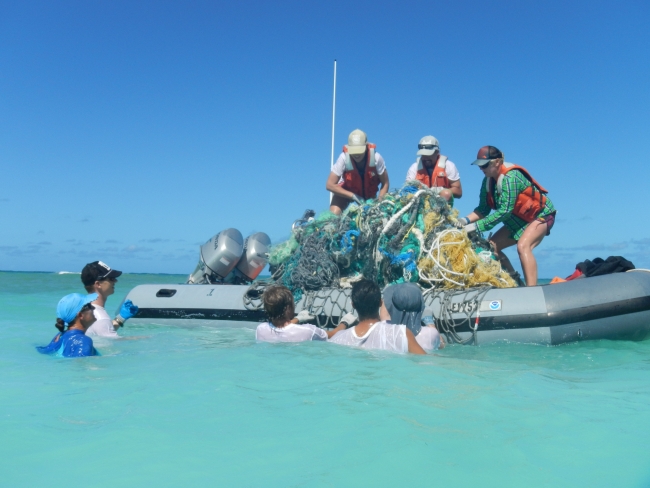Derelict fishing nets are a big marine debris problem. These nets can entangle wildlife, create major hazards to navigation, and can damage sensitive and important habitats. Unfortunately, they can also be difficult to address as they often have few identifying characteristics. This makes determining their source challenging and makes derelict nets difficult to track.
Derelict fishing nets are a particularly large problem in the Hawaiian archipelago, due to Hawaii’s geographic location in the North Pacific Gyre and Convergence Zone and the large amounts of fishing that occurs domestically and internationally in the Pacific. The North and East Coast shorelines of each Hawaiian Island are the most impacted, due to the northeast trade winds that blow this debris ashore. These nets may come from local origin or from far-off sources throughout the Pacific, but it’s difficult to tell without identifying markers such as a specific regional style (which can often be used to determine the general source of debris like derelict crab traps), serial numbers, or writing. Interestingly, Hawaii’s main commercial fishing industry is longline fishing targeting pelagic (open ocean) species, but the majority of the nets and ropes found in Hawaii are made of trawl or purse seine types, which suggests they are likely not of local origin.
No matter where these derelict nets hail from, they create a problem in this region that must be addressed. Prevention is the key to addressing marine debris, so raising awareness about the issue and educating fishermen is important. However, since the origin of most of these derelict nets is unknown and there are already many nets that litter Hawaiian shores, removal is also a very important part of solving the problem of derelict fishing nets. Recently, the NOAA Marine Debris Program (MDP) Pacific Islands Regional staff have received an increase in reports of huge derelict fishing net conglomerates, so removal efforts are particularly important.
There are currently many groups that are working to remove this debris, including the Hawai'i Wildlife Fund, which is leading net patrols and removing debris from over 200 miles of coastline on four different Hawaiian islands through a project recently funded by a MDP Community-based Marine Debris Removal Grant. Surfrider Kaua'i, previously funded by the MDP, is also active in conducting net patrols in Hawaii (check out the giant net they found!). In addition, there are numerous organizations performing beach cleanups in this area, including the State of Hawaii Department of Land and Natural Resources; these efforts have been an excellent example of the collaborative efforts put forth to implement the Hawai'i Marine Debris Action Plan. This removed debris is disposed of properly and when possible, and recycled through programs such as the Hawai'i Nets to Energy Program.
For more on derelict fishing nets in Hawaii, check out this 2014 interview with NOAA scientists.






